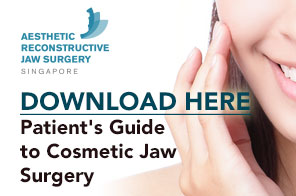Share this
Can Invisalign be used with Corrective Jaw Surgery in Singapore?
on July 14, 2016

One of the common bugbears of orthognathic patients is the need to have braces for two years or more. Many of them are young adults with an active social life and having metal tracks in the mouth is not exactly a positive fashion statement. Invisalign, a system of transparent orthodontic aligners generated by computer-aided design, is a revolutionary approach to aligning teeth. It has gain tremendous popularity due to the “invisible” nature of these appliances, eliminating the metal tracks altogether. Can Invisalign be used in orthognathic surgery cases?
The mindset of the jaw surgery patient…
An orthodontist colleague once told me that orthognathic patients are rather unfair. The orthodontist spends a year or so preparing the patient for surgery and then another year to fine-tune the occlusion postoperatively but it is the surgeon who spends a few days with the patient that gets the thank you card. It is good to be a surgeon. That is because most orthognathic patients are actually seeking surgical correction of their problem and the orthodontics is a necessary inconvenience that they have to tolerate in order to get the surgery. The converse is true. If the patient is not keen on surgery but found that his condition cannot be treated with braces alone tend not to like the surgery and by extension, the surgeon. So, as a surgeon, I make sure that I deal more with the former than the latter.
Surgery-first approach…
The success of “surgery-first” approach significantly reduces the amount of time needed for orthodontics. By eliminating the pre-surgical orthodontic treatment phase, as much as one year of treatment time may be saved. Furthermore, the phenomenon of accelerated movement of teeth after surgery also helps to shorten treatment duration. Of course, not all cases are suitable for surgery-first approach but most of the routine cases are. With improved understanding and planning, surgery-first approach can be very accurate in positioning the jaw bases in the desired position.
Invisalign + Surgery-first….
Combining Invisalign and surgery-first approach not only reduce the treatment duration but improves aesthetics and social acceptance during the orthodontic treatment phase.
Contraindications
However, Invisalign is not suitable for some cases. In a paper published in the Journal of the Canadian Dental Association, several conditions were listed as unsuitable e.g. crowding and spacing greater than 5mm, teeth that were rotated more than 20 degrees, open bites, teeth that are tilted more than 45 degrees, teeth with short clinical crowns, jaws with many missing teeth, amongst others.
Skeletal discrepancies between the upper and lower jaws were also listed as a contraindication. Does that mean that Invisalign is incompatible with corrective jaw surgery? No, what that means is that unlike conventional braces, Invisalign cannot be used to perform camouflage orthodontics for cases that actually need jaw surgery. However, if the case fulfill the requirements for a surgery-first approach, then Invisalign is a viable option for post-surgical orthodontics provided the other conditions are not violated.
For patients who want corrective jaw surgery but are unable to accept a prolong period of conventional orthodontics, combining a surgery-first approach together with postoperative orthodontic treatment with Invisalign may be the way to go.
Share this
- Jaw Surgery (93)
- Dental Implants Singapore (90)
- Orthognathic Surgery (48)
- Replacing Missing Teeth (26)
- Missing Teeth Options (23)
- Underbite (23)
- Bone Grafting (21)
- Costs (18)
- Facial Aesthetics (18)
- Aesthetics (17)
- dental implants (16)
- corrective jaw surgery (15)
- BOTOX (11)
- Dermal Fillers (11)
- Wisdom teeth (10)
- Fixed Implant Dentures (8)
- Loose Dentures Singapore (6)
- Medisave (6)
- sleep apnea (6)
- Braces (5)
- Dental Pain (5)
- Dentures in Singapore (5)
- Loose Teeth (5)
- Tooth Extraction (5)
- jaw deformities (5)
- bimax (4)
- bone graft (4)
- maxillomandibular advancement (4)
- all-on-4 (3)
- bimaxillary protrusion (3)
- chin implant (3)
- facial asymmetry (3)
- full mouth dental implants (3)
- genioplasty (3)
- immediate implant (3)
- removal of an integrated dental implant (3)
- third molars (3)
- wisdom tooth surgery (3)
- My Dentures Don't Fit (2)
- VME (2)
- bone graft healing (2)
- distraction osteogenesis (2)
- medical tourism (2)
- obstructive sleep apnea (2)
- orthodontics (2)
- plastic surgery (2)
- CT guided dental implants (1)
- Double jaw surgery (1)
- Invisalign (1)
- Periodontal Disease (1)
- Permanent Dentures Singapore (1)
- before and after photos (1)
- facial trauma (1)
- fractured dental implant (1)
- oral appliance therapy (1)
- root canal treatment (1)
- veneers (1)
- vertical maxillary excess (1)
- September 2019 (2)
- July 2019 (2)
- May 2019 (2)
- August 2018 (1)
- October 2017 (1)
- September 2017 (2)
- August 2017 (1)
- June 2017 (2)
- May 2017 (4)
- April 2017 (1)
- March 2017 (1)
- February 2017 (3)
- January 2017 (3)
- December 2016 (1)
- November 2016 (2)
- October 2016 (4)
- September 2016 (9)
- August 2016 (5)
- July 2016 (11)
- June 2016 (14)
- May 2016 (6)
- April 2016 (2)
- March 2016 (1)
- January 2016 (7)
- December 2015 (10)
- November 2015 (4)
- October 2015 (9)
- September 2015 (7)
- August 2015 (1)
- July 2015 (6)
- June 2015 (3)
- May 2015 (7)
- April 2015 (5)
- March 2015 (8)
- January 2015 (5)
- December 2014 (7)
- November 2014 (7)
- October 2014 (6)
- September 2014 (8)
- August 2014 (5)
- July 2014 (7)
- June 2014 (8)
- May 2014 (9)
- April 2014 (10)
- March 2014 (6)
- February 2014 (8)
- January 2014 (3)
Subscribe by email
Email subscription




Comments (1)